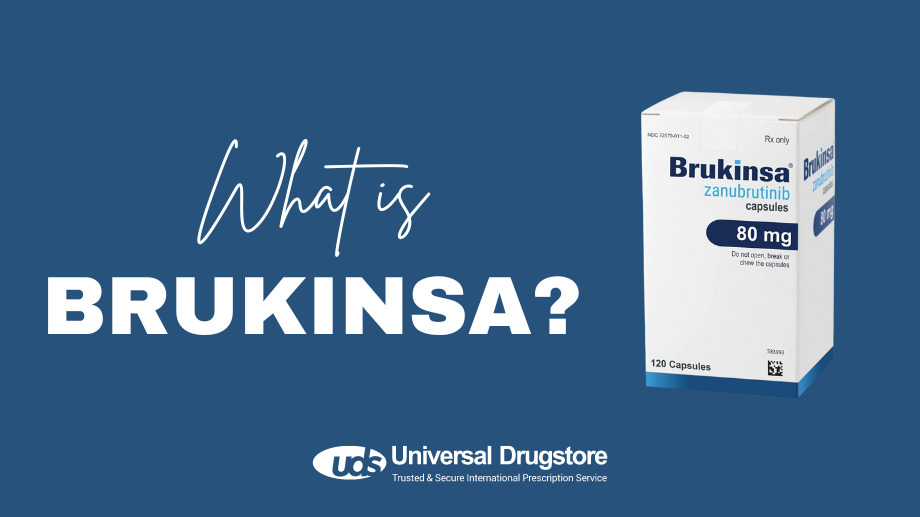What is Brukinsa?


Brukinsa (zanubrutinib), manufactured by BeiGene, is an oral kinase inhibitor oral used in the treatment of adult patients with specific hematologic (blood cell) cancers that affect the bone marrow, blood, and lymph nodes.
These cancers include mantle cell lymphoma (MCL) if you have had at least one prior therapy, Waldenström’s macroglobulinemia (WM) cancer, relapsed or refractory marginal zone lymphoma (MZL), and chronic lymphocytic leukemia (CLL) or small lymphocytic lymphoma (SLL). MCL and MZL are approved under accelerated approval based on the overall response rate.
It is unknown whether Brukinsa is safe for children.
How does Brukinsa work?
The active ingredient in Brukinsa is zanubrutinib. It works by blocking the formation of new cancerous cells in your body. Brukinsa does this by blocking the effects of the enzyme known as Bruton’s tyrosine kinase (BTK). Specifically, the BTK inhibitor targets cancerous lymphocytes called B cells. B-cells are responsible for MCL, MZL, and WM cancers. Brukinsa is not chemotherapy, so it does not target and kill cancer cells.
The efficacy of Brukinsa monotherapy (taken by itself), including duration of response, was shown in two major studies with an independent review committee:
-
Sequoia (testing Brukinsa against the chemotherapy drug bendamustine and rituximab).
-
Alpine (testing Brukinsa against Ibrutinib).
What doses of Brukinsa are available?
Brukinsa comes as an 80 mg oral capsule. Typically, the recommended dose is 160 mg twice daily or 320 mg once daily.
How do you use Brukinsa?
Brukinsa should be taken exactly as your healthcare provider tells you. Make sure you read all prescribing information and FDA-approved patient labeling (patient information) before using.
You may take Brukinsa with or without food, however, the capsules should be swallowed whole with a glass of water. Make sure not to chew, open or break the capsules.
Do not change your dosage or stop taking Brukinsa without talking to your healthcare provider. If you miss a dose, take it as soon as you remember. The next day, continue with your regular schedule.
What are the side effects of Brukinsa?
The most common side effects of Brukinsa in clinical trials compared to placebo include:
-
Upper respiratory tract infection
-
Bone, muscle, or joint pain
-
Decreased platelet count
-
Musculoskeletal pain
Brukinsa may cause some serious side effects, including:
-
Serious bleeding (hemorrhage). Tell your healthcare provider if you have any signs of hemorrhaging, including the possible symptoms:
-
Brown of pink urine
-
Vomiting blood or vomit that looks like coffee grounds
-
Cough up blood clots or blood
-
Dizziness or weakness
-
Black stools (looks like tar) or blood in stools
-
Persistent headache
-
-
A low red blood cell count (anemia)
-
A low white blood cell count including neutropenia (low neutrophil count)
-
Low platelet count (thrombocytopenia).
-
Serious infections.
-
Tell your healthcare provider right away if you have flu-like symptoms, a fever, or chills.
-
-
Heart rhythm problems including atrial flutter, atrial fibrillation, and ventricular arrhythmias. Let your healthcare provider know if you show any of the following symptoms:
-
Shortness of breath
-
Dizziness or lightheadedness
-
Faint or pass out
-
Irregular or fast heartbeat
-
-
Second primary malignancies.
-
Wear sunscreen while in the sun. Non-melanoma skin cancer was the most frequently reported second primary cancer.
-
Your doctor may screen you for cancer during Brukinsa treatment.
-
Contact your healthcare professional for medical advice about any possible adverse reactions you experience while taking Brukinsa. You can report your adverse reactions to the U.S. Food and Drug Administration at 1-800-FDA-1088 or www.fda.gov/medwatch.
Brukinsa drug interactions
When Brukinsa is taken with other prescription drugs, over-the-counter medications, vitamins, and supplements, it may change how they work or increase the frequency or severity of side effects. Some drug interactions with Brukinsa include:
-
CYP3A Inhibitors such as clarithromycin, erythromycin, itraconazole, ketoconazole, diltiazem, and grapefruit
-
Brukinsa dose should be moderated with CYP3A inhibitors.
-
-
CYP3A Inducers such as rifampin, carbamazepine, phenobarbital, and phenytoin
-
You should not take Brukinsa with strong CYP3A inducers.
-
Brukinsa dose could be readjusted with moderate CYP3A inducers if you cannot avoid taking it.
-
Brukinsa precautions
You should be sure that your healthcare provider is aware of all your medical conditions, including if you have:
-
Bleeding problems
-
You are at a very high risk of bleeding if you have preexisting bleeding issues.
-
-
Heart rhythm problems
-
Had surgery recently or plan to have surgery
-
Your healthcare provider may stop Brukinsa if you have a planned surgical, medical, or dental procedure.
-
-
High blood pressure
-
An infection
-
Liver problems including a history of a hepatitis B infection.
-
A pregnancy or plan to become pregnant.
-
Brukinsa has embryo-fetal toxicity and can cause harm to your unborn baby.
-
If you are able to become pregnant, you may have to:
-
Take a pregnancy test before starting Brukinsa treatment.
-
Avoid pregnancy by using effective birth control while taking Brukinsa and up to one week after the last dose of Brukinsa.
-
-
If you can get a female pregnant, you should use effective birth control methods during treatment and for one week after the last dose of Brukinsa.
-
-
A plan to breastfeed or are breastfeeding.
-
Do not breastfeed while taking Brukinsa and for two weeks after the last dose.
-
Is there a generic available for Brukinsa?
Currently, there is no generic available for Brukinsa in the United States.
How do you store Brukinsa?
Brukinsa capsules should be stored at room temperature (68°F to 77°F or 20°C to 25°C). All bottles come in a child-resistant cap and should be kept away from children.
Related medications
Sources
Brukinsa.com: https://www.brukinsa.com/
Prescribing information: https://www.brukinsa.com/prescribing-information.pdf
Patient information: https://www.brukinsa.com/patient-information.pdf
GoodRx: https://www.goodrx.com/brukinsa/what-is#alternatives
Daily Med: https://dailymed.nlm.nih.gov/dailymed/lookup.cfm?setid=3e08fe23-d70e-424c-bc51-1222e320f902
Brukinsa Studies: https://www.brukinsa.com/hcp/cll/study-design


